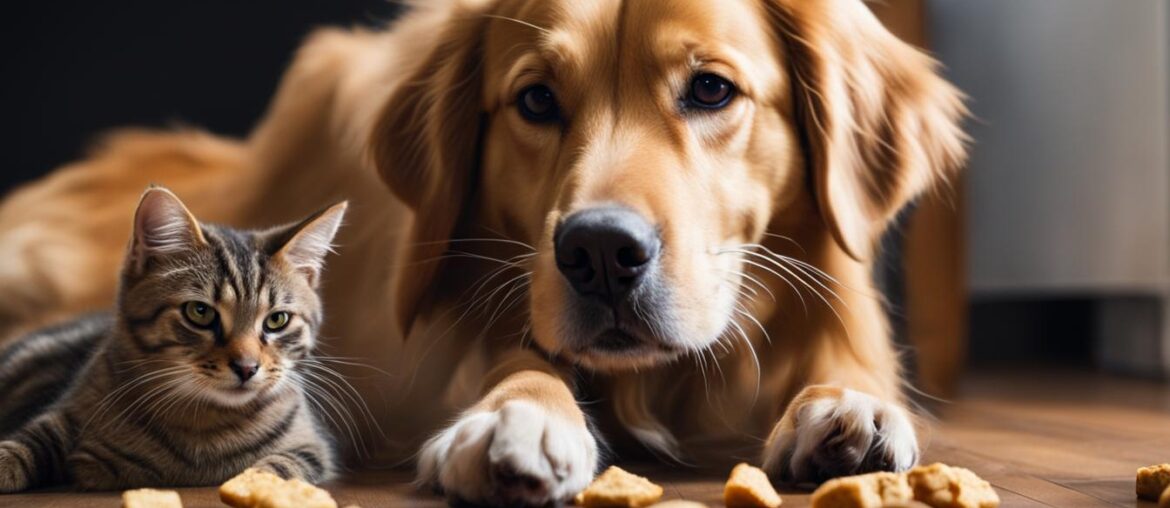Dogs and cats have different nutritional needs, and as a result, their diets should consist of species-specific foods. While dogs can technically eat cat treats, it is not recommended to make it a regular part of their diet. Cat treats are formulated with the nutritional needs of felines in mind, which may not meet the nutritional requirements of dogs. Feeding dogs cat treats too often can lead to chronic health issues due to an imbalance of nutrients. It’s best to choose treats specifically made for dogs to ensure they receive the proper balance of nutrients.
Key Takeaways:
- Feeding dogs cat treats is not recommended as they have different nutritional needs than cats.
- Cat treats may not meet the requirements for a balanced diet for dogs and can lead to health issues if consumed too often.
- Choosing treats specifically made for dogs is the best way to ensure they receive proper nutrition.
- Consulting with a veterinarian can provide further guidance on suitable treats for dogs.
- While occasional sharing of treats between dogs and cats is generally safe, it’s important to prioritize species-specific treats for long-term health.
The Difference Between Dog Treats and Cat Treats
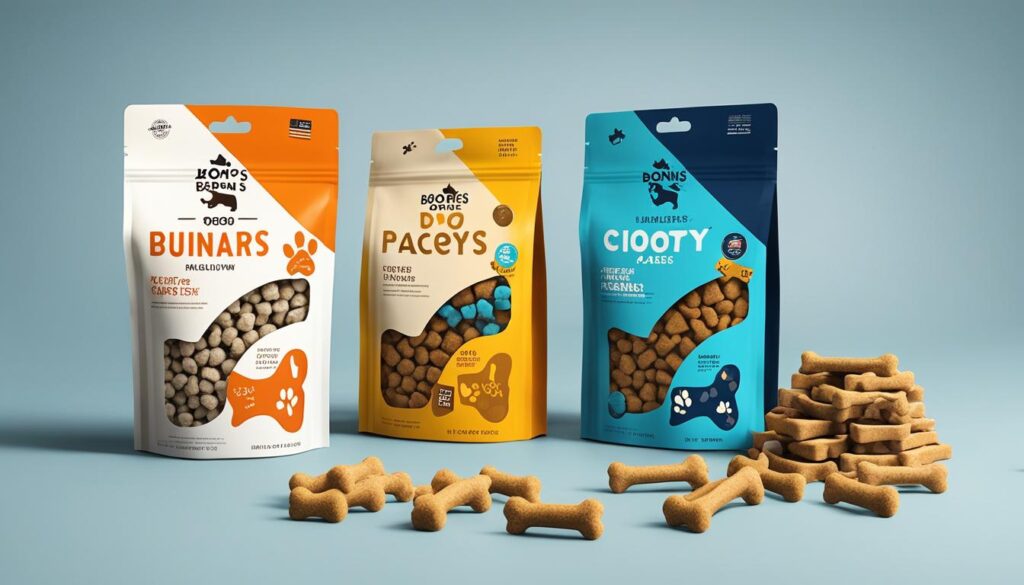
Dog treats and cat treats differ in their nutritional content, ingredients, and texture. Dogs and cats have different nutritional needs, so it’s important to choose treats specifically formulated for each species to meet their unique requirements.
For instance, dogs require more carbohydrates in their diet compared to cats. Carbohydrates provide energy and support bodily functions in dogs. On the other hand, cats are obligate carnivores and have a higher need for protein. Their bodies are adapted to digest and utilize animal protein more efficiently.
Cat treats generally have a higher protein content and lower carbohydrate content compared to dog treats. This is because cats’ bodies utilize protein as a major energy source. Dog treats, on the other hand, have a more balanced ratio of protein, fat, and carbohydrates to meet the needs of dogs.
Both dogs and cats require essential amino acids and vitamins, but the specific amounts differ. These essential nutrients play various roles in their overall health and well-being.
Here is a comparison of the nutritional content typically found in dog treats and cat treats:
| Nutrient | Dog Treats | Cat Treats |
|---|---|---|
| Protein | Nutritional=value for dogs contain protein that supports muscle development and repair. | Nutritional=value for cats contain higher protein content, as cats have a higher need for this nutrient. |
| Carbohydrates | Nutritional=value for dogs contain a moderate amount of carbohydrates to provide energy. | Nutritional=value for catscontain a lower amount of carbohydrates as cats are more reliant on protein. |
| Fat | Nutritional=value for dogs contain a balance of fat to provide energy and support various bodily functions. | Nutritional=value for cats contain a moderate amount of fat to provide essential fatty acids. |
| Vitamins | Nutritional=value for dogs include essential vitamins such as vitamin A, vitamin E, and vitamin C. | Nutritional=value for cats include essential vitamins such as vitamin A, vitamin E, and vitamin D. |
It’s important to note that these nutritional differences are not absolute, and there may be some overlap between dog treats and cat treats. However, to ensure optimal nutrition and meet the specific needs of each species, it is recommended to choose treats formulated for dogs or cats accordingly.
Can Dogs Eat Cat Treats (and Vice Versa)
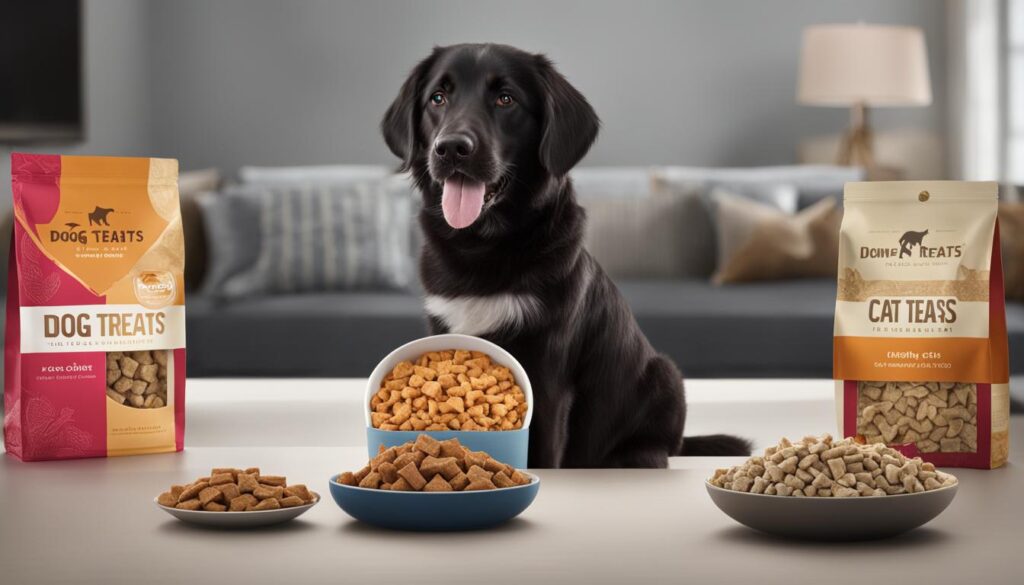
While dogs can technically eat cat treats and vice versa, it is not recommended to make it a regular occurrence. Cat treats are formulated to meet the nutritional needs of cats, while dog treats are designed for dogs. Feeding cat treats to dogs may cause an imbalance of nutrients in their diet, leading to chronic health issues. Feeding dog treats to cats may not provide the essential nutrients they require for optimal health.
When it comes to the safety of feeding cat treats to dogs, it’s important to consider the nutritional requirements of both species. Dogs have different nutritional needs compared to cats, with variations in the required protein, fat, and carbohydrate levels. Cat treats tend to have higher protein content and lower carbohydrate content, which can potentially upset the delicate nutritional balance of a dog’s diet.
Similarly, feeding dog treats to cats may not provide the necessary nutrients they require. Cats have specific dietary needs, including higher levels of protein and certain amino acids, that dog treats may not fulfill. Feeding dog treats to cats regularly may result in nutritional deficiencies and unhealthy weight gain.
It’s best to choose treats that are specifically made for each species to ensure their nutritional needs are met. Dog treats are formulated to provide the appropriate balance of nutrients for dogs, while cat treats are formulated to meet the unique requirements of cats. By sticking to treats specifically made for their respective species, pet owners can ensure their dogs and cats receive the appropriate nutrition without compromising their health.
If you are unsure about what treats are suitable for your pets or have any concerns about their diet, it’s always best to consult with your veterinarian. They can provide personalized recommendations based on your pets’ specific needs and help you make informed decisions regarding their dietary choices.
Nutritional Comparison of Cat and Dog Treats
| Nutrient | Cat Treats | Dog Treats |
|---|---|---|
| Protein | Higher content | Balanced content |
| Carbohydrates | Lower content | Moderate content |
| Fat | Varies depending on the treat | Varies depending on the treat |
| Amino Acids | Catered to feline needs | Catered to canine needs |
| Vitamins | Adjusted for feline health | Adjusted for canine health |
The table above highlights the nutritional differences between cat and dog treats. While there may be variations among specific brands and products, it is essential to choose treats that align with the nutritional requirements of your pets. This ensures that they receive the proper balance of nutrients and maintain their overall health and well-being.
The Risks of Feeding Cat Treats to Dogs
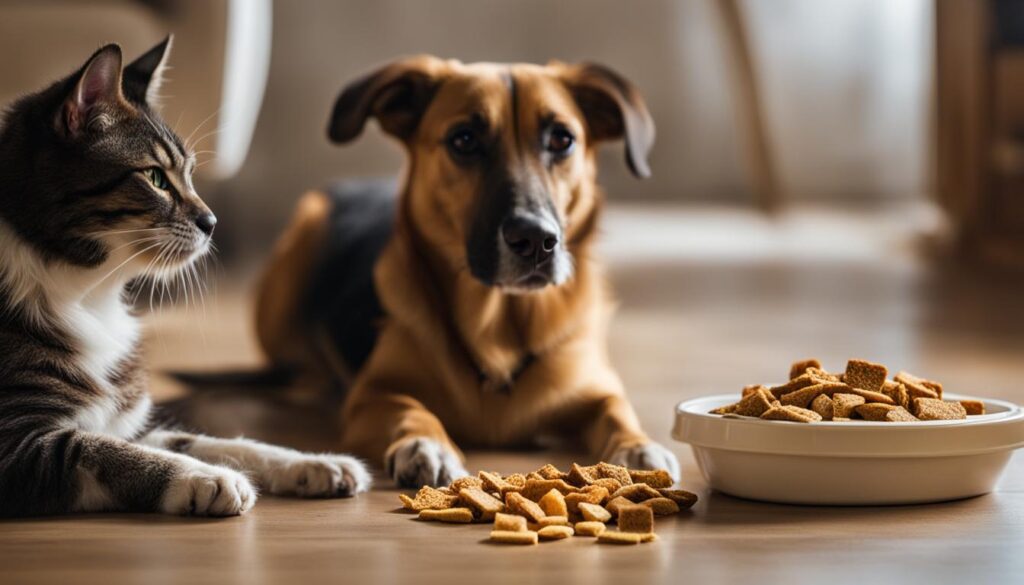
Feeding cat treats to dogs can pose significant risks to their health. While it may be tempting to share treats between your furry companions, it’s important to understand the potential consequences for your dog.
Obesity in Dogs: Cat treats often have a higher calorie content than dog treats. Feeding your dog these calorie-dense treats frequently can contribute to weight gain and obesity. Just like humans, obesity in dogs can lead to a wide range of health problems, including joint issues, heart disease, and diabetes.
Digestive Issues in Dogs: Cat treats are formulated with the nutritional needs of felines in mind, which can differ significantly from those of dogs. The higher protein and fat content in cat treats can cause digestive issues in dogs, leading to discomfort, stomach cramps, and even diarrhea.
Allergies in Dogs: Dogs, just like humans, can develop allergies to certain ingredients. Feeding your dog cat treats exposes them to potential allergens that may trigger itching, skin irritation, ear infections, and other allergic reactions. It’s crucial to be aware of any existing allergies your dog may have and avoid ingredients known to cause reactions.
It’s essential to prioritize your dog’s health and choose treats specifically made for dogs. By doing so, you can avoid these potential health problems and ensure that your dog receives the proper nutrition they need.
The Risks of Feeding Dog Treats to Cats
Feeding dog treats to cats can have detrimental effects on their health. While dogs and cats may share some similarities in terms of their dietary needs, there are important distinctions that make dog treats unsuitable for feline consumption.
- Weight Gain in Cats: Dog treats often contain higher levels of carbohydrates and fats compared to treats specifically formulated for cats. This can contribute to weight gain in cats, increasing the risk of obesity and related health issues such as diabetes and joint problems.
- Allergies in Cats: Some ingredients commonly found in dog treats, such as beef or grains, may trigger allergic reactions in cats. Cats can develop skin irritations, itching, and gastrointestinal upset as a result of consuming dog treats.
- Kidney Disease in Cats: Certain dog treats may contain higher levels of protein, which can put a strain on a cat’s kidneys. Cats are obligate carnivores and require a specific balance of nutrients, including protein, to maintain optimal health. Consuming dog treats can potentially lead to kidney disease in cats.
- Potential Health Problems: Feeding dog treats to cats on a regular basis can result in various health problems due to the nutritional disparities between the two species. Cats require certain amino acids, vitamins, and minerals that may be inadequate or absent in dog treats, leading to nutrient deficiencies and imbalances.
To ensure the well-being of your feline companion, it’s crucial to choose treats that are specifically formulated for cats. These treats are designed to meet their unique nutritional needs, ensuring a balanced diet and reducing the risk of potential health issues.
Safe Treats for Both Dogs and Cats
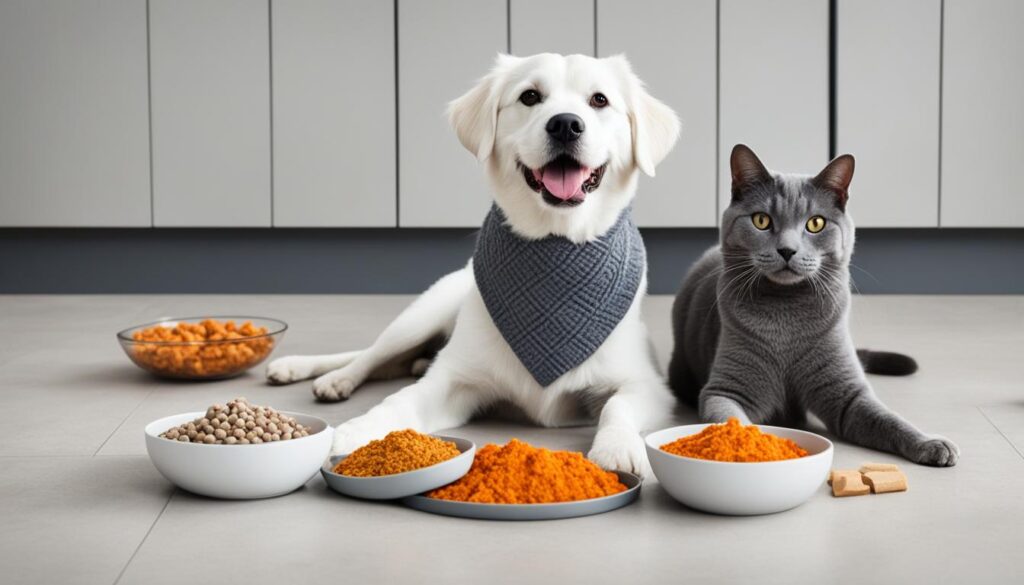
While dogs and cats have different dietary needs, there are some treats that can be safely shared between the two species. Here are some safe and healthy options for treats that can be enjoyed by both dogs and cats:
Cooked Meat and Fish
Cooked meat and fish, such as turkey, chicken, and salmon, can be a safe treat for both dogs and cats. These protein-rich options can be offered in small quantities as an occasional treat. When preparing the meat or fish, ensure it is cooked thoroughly and free from any seasoning or spices that may be harmful to pets.
Eggs
Eggs, with the exception of raw eggs, are also a healthy treat that can be shared by both dogs and cats. They are a good source of protein, vitamins, and minerals. Cooked eggs can be mashed or chopped into small pieces for a tasty and nutritious snack.
Veggies
Certain vegetables can provide vitamins and minerals for both dogs and cats. Some safe vegetable options for treats include bell peppers, broccoli, carrots, cucumber, pumpkin, and zucchini. These vegetables can be steamed or chopped into small, bite-sized pieces before serving. Vegetables should always be introduced gradually and in moderation to ensure they are well-tolerated by your pets.
Fruits
Some fruits can also be given as a treat to both dogs and cats. Apples, bananas, blueberries, strawberries, and watermelon are examples of fruits that can be shared in small amounts. It’s important to remove any seeds or pits and cut fruits into small, manageable pieces before offering them to your pets. Be mindful of portion sizes and any fruit-specific dietary restrictions or sensitivities your pet may have.
| Treat | Description |
|---|---|
| Cooked Meat and Fish | Protein-rich options like turkey, chicken, and salmon |
| Eggs | A healthy treat packed with protein, vitamins, and minerals |
| Veggies | Nutrient-rich vegetables like bell peppers, broccoli, carrots, cucumber, pumpkin, and zucchini |
| Fruits | Safe fruits such as apples, bananas, blueberries, strawberries, and watermelon |
When offering these treats to your pets, it’s important to ensure they are safe and suitable for both dogs and cats. Always consult with your veterinarian before introducing any new treats to your pets’ diets to ensure they align with their individual nutritional needs and any specific dietary restrictions.
Why Do Dogs Love Cat Treats?

Dogs have a curious affinity for cat treats, and there are a few reasons why this might be the case. One factor is the higher protein content found in most cat treats compared to dog treats. Dogs are naturally carnivorous animals, and they have a preference for meat-based protein. Cat treats often fulfill this preference, making them more appealing to dogs.
Another reason is the stronger smell and flavor of cat treats. Cats are known for their keen sense of smell, and their treats are often designed to have a more potent aroma and taste. This can make cat treats more enticing to dogs, who are attracted to the rich scents and flavors.
Despite their love for cat treats, it’s important to note that dogs have different nutritional needs than cats. While occasional indulgence is generally harmless, it’s best to choose treats specifically made for dogs to ensure they receive the proper balance of nutrients.
Similarities between Cat Treats and Dog Treats
Despite the differences in nutritional needs, there are some similarities between cat treats and dog treats. Both types of treats are designed to reward and indulge our beloved pets. They are often used during training sessions or as a special treat for good behavior.
Additionally, both cat treats and dog treats can serve as a source of pleasure and mental stimulation for our furry friends. Chewing on treats can help relieve stress and anxiety, and the act of enjoying a tasty morsel can provide comfort and satisfaction.
However, when it comes to choosing treats for our pets, it’s essential to consider their specific nutritional requirements to ensure their overall health and well-being.
| Treat | Similarities | Differences |
|---|---|---|
| Cat Treats | Both cats and dogs enjoy the taste and texture of treats. | Cat treats have a higher protein content and stronger smell and flavor compared to dog treats. |
| Dog Treats | Both cats and dogs can benefit from the mental stimulation and reward aspect of treats. | Dog treats are formulated to meet the specific nutritional needs of dogs. |
While dogs may have a fondness for cat treats, it’s important to prioritize their health by providing them with treats specifically formulated for dogs. These treats are designed to meet their unique nutritional requirements, ensuring they receive all the essential nutrients they need to thrive.
How to Prevent Dogs from Eating Cat Treats
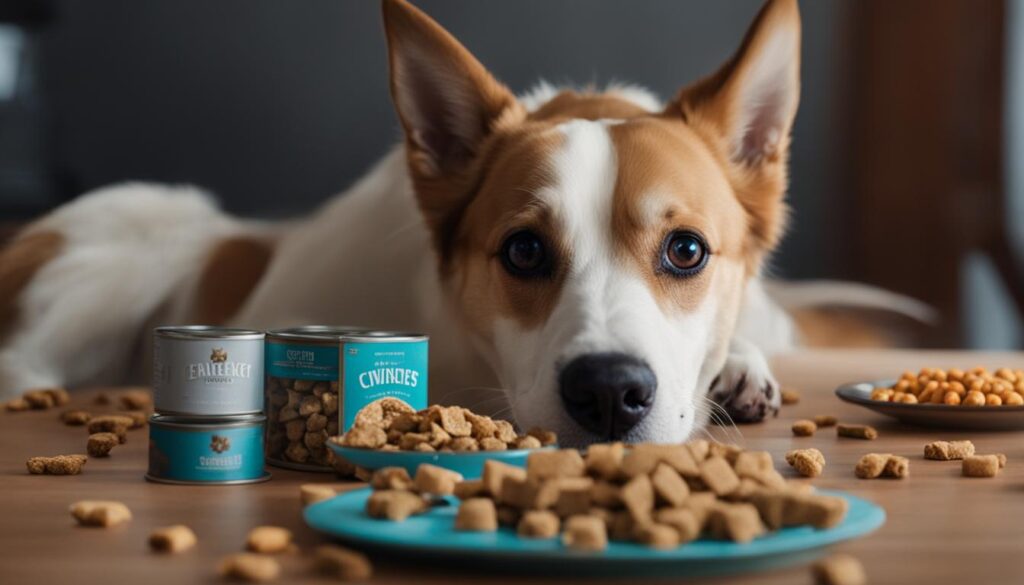
To ensure the safety and well-being of your pets, it’s essential to take preventive measures to stop dogs from eating cat treats. By implementing a few simple strategies, you can effectively manage and control your pets’ treat consumption.
Storing Treats Separately
One of the most crucial steps in preventing dogs from eating cat treats is to store the treats separately. Use labeled containers and keep them in different areas, such as high shelves or closed cabinets, where your dog cannot access them. This way, you can avoid any accidental consumption by your dog.
Supervising Pets During Treat Time
When giving treats to your pets, it’s essential to supervise them to ensure that your dog doesn’t get hold of the cat treats. By closely monitoring treat time, you can intervene and avoid any potential incidents where your dog may try to sneak a bite of the cat’s treats.
Training Dogs to “Leave It”
Training your dog to “leave it” is a valuable command that can help prevent them from eating cat treats. Use positive reinforcement techniques to train your dog to ignore the treats or to divert their attention elsewhere when they encounter them. It’s an effective way to teach them self-control and impulse management.
Feeding Pets Separately
To prevent your dog from eating the cat’s food or treats, it’s recommended to feed your pets in separate areas or at different times. This approach eliminates any opportunity for your dog to access the cat’s treats or vice versa. It also helps ensure that each pet receives their specific diet without any interference.
Using Pet Gates or Barriers
Pet gates or barriers can be used to create physical boundaries and separate your pets during mealtime or treat time. This ensures that your dog cannot reach the area where the cat treats are kept. It provides an additional layer of safety and prevents any unwanted consumption by your dog.
Providing Exercise and Mental Stimulation for Dogs
Regular exercise and mental stimulation play a crucial role in reducing your dog’s interest in finding and eating cat treats. Engage your dog in physical activities such as daily walks, playing fetch, or interactive games that challenge their mind. Keeping your dog physically and mentally stimulated helps redirect their focus and reduces their desire for cat treats.
By following these preventive measures, you can effectively prevent dogs from eating cat treats. Remember, the health and safety of your pets should always be a top priority.
Can Dogs Eat Catnip Treats?
Dogs can safely consume catnip treats in small amounts. Catnip is a leafy green herb that belongs to the mint family and has a unique effect on cats. However, it can also have calming effects on anxious dogs and may help promote better sleep.
Catnip contains beneficial minerals and vitamins and has natural antiseptic properties that can aid in healing minor external cuts or scrapes. It’s important to check the ingredients list of catnip-based treats to ensure they do not contain any ingredients that are harmful to dogs.
While not all dogs are responsive to catnip, those that are can benefit from the calming effects it provides. However, moderation is key when it comes to offering catnip treats to dogs. It’s best to consult with your veterinarian to determine the appropriate frequency and dosage based on your dog’s individual needs.
When introducing catnip treats to your dog, start with small amounts and monitor their response. Some dogs may become overly excited or exhibit increased playfulness after consuming catnip treats, so it’s important to observe their behavior and adjust accordingly.
Key Points:
- Dogs can safely consume catnip treats in small amounts.
- Catnip can have calming effects on anxious dogs and promote better sleep.
- Catnip contains beneficial minerals, vitamins, and natural antiseptic properties.
- Check the ingredients list of catnip treats to ensure they are safe for dogs.
- Start with small amounts of catnip treats and monitor your dog’s response.
Wrapping Up
While dogs can eat cat treats and vice versa, it’s not recommended to make it a regular occurrence. Dogs and cats have different nutritional needs, and feeding them treats specifically formulated for their species is important to maintain their health and well-being.
It’s best to choose treats made specifically for dogs to ensure they receive the proper balance of nutrients, and the same goes for cats. Sharing treats between the two species occasionally is generally safe, but it’s important to consult with your veterinarian if you have any concerns about your pets’ diets or health.
Remember, dogs and cats are unique animals with specific dietary requirements, and their well-being should always be our top priority. By selecting treats that are tailored to their needs, we can ensure that they receive the necessary nutrients for optimal health and happiness.
FAQ
Is it safe for dogs to eat cat treats?
While dogs can technically eat cat treats, it is not recommended to make it a regular part of their diet. Cat treats are formulated with the nutritional needs of felines in mind, which may not meet the nutritional requirements of dogs. Feeding dogs cat treats too often can lead to chronic health issues due to an imbalance of nutrients. It’s best to choose treats specifically made for dogs to ensure they receive the proper balance of nutrients.
What is the difference between dog treats and cat treats?
Dog treats and cat treats differ in their nutritional content, ingredients, and texture. Dogs and cats have different nutritional needs, with dogs requiring more carbohydrates in their diet compared to cats. Cat treats have higher protein content and lower carbohydrate content, while dog treats have a more balanced ratio of protein, fat, and carbohydrates. Both species require essential amino acids and vitamins, but the specific amounts differ. It’s important to choose treats that are specifically formulated for each species to meet their unique nutritional needs.
Can dogs eat cat treats, and vice versa?
While dogs can technically eat cat treats and vice versa, it is not recommended to make it a regular occurrence. Cat treats are formulated to meet the nutritional needs of cats, while dog treats are designed for dogs. Feeding cat treats to dogs may cause an imbalance of nutrients in their diet, leading to chronic health issues. Feeding dog treats to cats may not provide the essential nutrients they require for optimal health. It’s best to choose treats specifically made for each species to ensure their nutritional needs are met.
What are the risks of feeding cat treats to dogs?
Feeding cat treats to dogs can pose risks to their health. Cat treats often have higher calorie content than dog treats, which can contribute to obesity in dogs if consumed too often. The higher protein and fat content in cat treats can also cause digestive issues in dogs, such as stomach cramps and intestinal discomfort. Additionally, some dogs may be allergic to certain ingredients in cat treats, leading to itching, skin irritation, and ear infections. It’s important to choose treats specifically made for dogs to avoid potential health problems.
What are the risks of feeding dog treats to cats?
Feeding dog treats to cats can also pose risks to their health. Dog treats may not provide the necessary nutrients and amino acids that cats require, leading to weight gain and potential health issues. Additionally, some dog treats may contain ingredients that are toxic to cats or may cause allergies in felines. Dogs treats often have higher levels of carbohydrates, which can be difficult for cats to digest. This can lead to vomiting, loose stools, and an upset stomach. It’s best to choose treats specifically made for cats to ensure their unique nutritional needs are met.
What are safe treats for both dogs and cats?
While dogs and cats have different dietary needs, there are some treats that can be safely shared between the two species. Cooked meat and fish, such as turkey, chicken, and salmon, can be a safe treat for both dogs and cats. Eggs, with the exception of raw eggs, are also a healthy treat that can be shared by both species. Certain vegetables, like bell peppers, broccoli, carrots, cucumber, pumpkin, and zucchini, can provide vitamins and minerals for both dogs and cats. Some fruits, including apples, bananas, blueberries, strawberries, and watermelon, can also be given as a treat to both species. It’s important to ensure that the treats are safe and suitable for both dogs and cats, and to consult with your veterinarian before introducing any new treats to your pets’ diets.
Why do dogs love cat treats?
Dogs may be drawn to cat treats because of their higher protein content compared to dog treats. The stronger smell and flavor of cat treats can also be more appealing to dogs. Additionally, dogs are naturally carnivorous and have a preference for meat-based protein, which is often found in cat treats. However, it’s important to remember that while dogs may enjoy the taste of cat treats, it’s best to choose treats specifically made for dogs to ensure their nutritional needs are met.
How can I prevent dogs from eating cat treats?
To prevent dogs from eating cat treats, it’s important to store treats separately and in labeled containers. Keep them in different areas to ensure your dog cannot access the cat treats. When giving treats to your pets, supervise them to prevent dogs from eating cat treats. Train your dog to “leave it” to resist the temptation of eating cat treats. Feed your pets in separate areas or at different times to prevent your dog from eating the cat’s food or treats. Consider using pet gates or barriers to separate your pets during mealtime. Providing exercise and mental stimulation for your dog can also reduce their interest in finding and eating cat treats.
Can dogs eat catnip treats?
Dogs can safely consume catnip treats in small amounts. Catnip is a leafy green herb that belongs to the mint family and has a unique effect on cats. However, it can also have calming effects on anxious dogs and may help promote better sleep. Catnip contains beneficial minerals and vitamins and has natural antiseptic properties that can aid in healing minor external cuts or scrapes. It’s important to check the ingredients list of catnip-based treats to ensure they do not contain any ingredients that are harmful to dogs.


